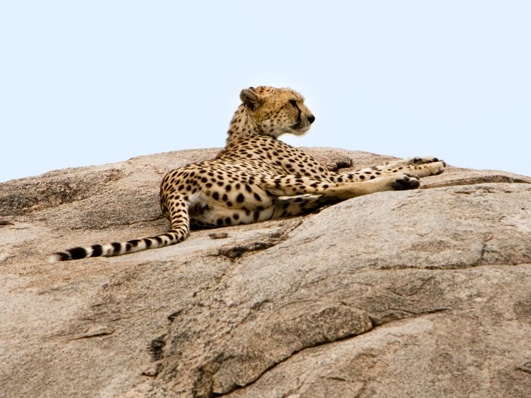Fact: A variation of the cheetah is the king cheetah. King cheetahs have black splotches on their coats instead of spots, and they have black stripes running down their backs. Kings are very rare in the wild, the last having been "spotted" in the 1990's. It is thought that there are 30 kings in existence, 10 of them living in the wild. Once thought to be a different species, we now know that kings are simply a mutant form of the cheetah.
Source: BigCats.com, and Tigerhomes.org.
Fact: While cheetahs prefer to chase their prey on the open plains, king cheetahs can be found in forests, stalking their next meal. Cheetahs hunt during the day, while kings hunt at night. Since splotches are better camouflage for partially lit environments, the coats of king cheetahs are better suited to shady forests.
Source: King Cheetah: The Story of the Quest, by Lena Godsall Bottriell, page 13.
Fact: Cheetahs were listed as an endangered species on June 2, 1970.
Source: U.S. Fish & Wildlife Service.

A cheetah near the Ngorongoro Cater
Image Source: Rob Qld / License under Creative Commons 2.0.
Available in three sizes:
1280 x 1024 || 1024 x 768 || 800 x 600
Fact: For centuries, the cheetah was known as "the hunting leopard," as man would use these trained lithe animals to help catch game for their human masters.
Source: Zoo Books, Big Cats, page 15.
 Fact: "... they introduced into France at great expense foreign animals, which they took great pains in naturalising as game or in training as auxiliaries in hunting. After having imported the reindeer from Lapland, which did not succeed in their temperate climate, and the pheasant from Tartary, with which they stocked the woods, they imported with greater success the panther and the leopard [cheetah] from Africa, which were used for furred game as the hawk was for feathered game. The mode of hunting with these animals was as follows: The sportsmen, preceded by their dogs, rode across country, each with a leopard sitting behind him on his saddle. When the dogs had started the game the leopard jumped off the saddle and sprang after it, and as soon as it was caught the hunters threw the leopard a piece of raw flesh, for which he gave up the prey and remounted behind his master. Louis XI., Charles VIII., and Louis XII. often hunted thus. The leopards, which formed a part of the royal venery, were kept in an enclosure of the Castle of Amboise, which still exists near the gate des Lions, so called, no doubt, on account of these sporting and carnivorous animals being mistaken for lions by the common people."
Fact: "... they introduced into France at great expense foreign animals, which they took great pains in naturalising as game or in training as auxiliaries in hunting. After having imported the reindeer from Lapland, which did not succeed in their temperate climate, and the pheasant from Tartary, with which they stocked the woods, they imported with greater success the panther and the leopard [cheetah] from Africa, which were used for furred game as the hawk was for feathered game. The mode of hunting with these animals was as follows: The sportsmen, preceded by their dogs, rode across country, each with a leopard sitting behind him on his saddle. When the dogs had started the game the leopard jumped off the saddle and sprang after it, and as soon as it was caught the hunters threw the leopard a piece of raw flesh, for which he gave up the prey and remounted behind his master. Louis XI., Charles VIII., and Louis XII. often hunted thus. The leopards, which formed a part of the royal venery, were kept in an enclosure of the Castle of Amboise, which still exists near the gate des Lions, so called, no doubt, on account of these sporting and carnivorous animals being mistaken for lions by the common people."
Source: Manners, Custom and Dress During the Middle Ages and During the Renaissance Period, by Paul Lacroix.
Fact: In Hindi, the word "cheetah" means "spotted one."
Source: NATURE: Cheetahs in a Hot Spot - Fast Cats.

A cheetah lounging in the Serengeti
Image Source: James Temple/ License under Creative Commons 2.0.
Available in two sizes:
1024 x 768 || 800 x 600
Cheetahs can go from 0 to 45 mph (72 km) in how many seconds?
Source: The Wild Ones Animal Index
Fact: At the end of a chase, cheetahs can take up to 150 breaths in one minute. Their respiration is so fast, it's hard for people to count them individually.
Source: Built for Speed: The Extraordinary, Enigmatic Cheetah, by Sharon Elaine Thompson, page 25.
Fact: Cheetahs are not strongly built cats, and are unable to defend their kills from lions and hyenas. When they do make a successful kill, cheetahs will gorge themselves because it may be some time until they eat again. Normally, cheetahs only get to eat every one to three days.
Source: National Geographic, December 1999, Cheetahs—Ghosts of the Grasslands, by Richard Conniff, page 14.